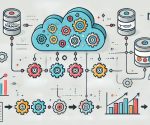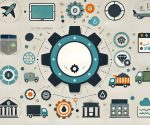Artificial intelligence (AI) can be defined as building machines to think, learn, and act like humans. It uses computer programs to perform tasks such as understanding language, recognizing images, solving problems, and making predictions. To understand what artificial intelligence is, we need to see it as a mechanism that can make your machine act smartly. From smartphones to self-driving cars, artificial intelligence is present in every aspect of our life now shaping the future for all industries.
What is Artificial Intelligence?
Artificial intelligence (AI) refers to any type of machine or computer software that can do what seems like human work. For instance, these tasks can range from learning, problem-solving, understanding natural language, and even sensing the environment. AI systems use data to recognize patterns and make decisions just as a human brain would.
These are just a few practical applications for the theory of artificial intelligence. Every day, companies, universities, hospitals, and factories are using AI to improve performance, eliminate errors and save time. AI is the foundation of a new generation of computing, which creates value for people and businesses. For example, Optical Character Recognition (OCR) uses AI image analysis to extract text and data from images and documents; it can transform unstructured content into business-ready structured data and unlock customer’s actual needs.
How Does Artificial Intelligence Work?
AI works by taking in large amounts of data and processing it–using its algorithms–to make decisions or, through this information, predictions It also learns from itself over time: the learning process 2 allows AI to improve With human artificial intelligence. In some respects, AI emulates human intelligence, only it is much faster, and usually more accurate at most tasks.
- Input: Data has always been extracted from various sources, but it needs sorting today. When this is done, that data becomes pure and easy for the machine AI to understand.
- Processing: The AI looks for similarities between data and combines them into patterns it has been programmed to understand. The AI uses these patterns to understand the problem better, thus processing much more quickly.
- Outcomes: From there, the AI can use these patterns to make predictions. For example, product ratings and traffic conditions can be forecast in advance by it.
- Adjustments: If it is determined that the data sets are a failure, AI learns from this mistake and goes through the process again under different conditions. This will progressively improve the accuracy of a model over time through trial and error.
- Assessments: In this way, AI is always learning to be better. Every such learning turns the system up a notch in intelligence–making it better and more responsible for being more credibly on the verge of decision-making.
Types of Artificial Intelligence
Since we comprehend the types of artificial intelligence, we can have an educated knowledge about how sophisticated and capable AI or any of its applications can be. Each was divided by abilities into three main types. This second type is AGI (Artificial General Intelligence): it is the only kind of AI that can understand science fiction data sets that were not directly fed to it,e.g., how a story is developing or what the trends in ideas from different languages are.
Narrow AI (Weak AI)
Narrow AI, or Weak Al, is designed to perform one specific task. It accepts simple input from outside sources and returns a binary answer–little in the way of reasoning power. Examples include spam filters, facial recognition systems, and virtual assistants like Siri or Alexa. These are the most common types of AI applications today. They perform great in unique jobs, such as translating languages and recommending products to you; however, regarding its appearance, AI looks like goal-oriented logic coupled with a human interface and rules for its operation on the one hand. It only follows predetermined rules, even if it sometimes seems intelligent.
General AI (Strong AI)
With regard to science fiction books and movies, general AI, called Strong AI, is a very familiar concept. This form of artificial intelligence can comprehend, plan, and make decisions in different tasks without being re-programmed. In contrast to conventional AI, general AI should be able to think, adjust, and resolve problems independently. At the research and development stage, it is still not available. Scientists are striving to develop systems that match human-level intelligence, but this challenge may take many more years to solve.
Super AI
A concept out of left field is neither proof nor disproof of super AI. It is a highly effective challenge to future chinese technological development. The notion of super Ai can lead to the anthropomorphization of machines, whereby people start to like and trust them. These researchers are also studying how to build safe and fair AI systems for the day Super AI becomes a physical reality, but few research centers take on this role.
Artificial Intelligence Training Models
Smart AI requires training, and to achieve its goal, it needs to be taught explicitly how to respond based on data. Training models are systems or algorithms that teach the AI to respond based on data. Based on the task and data available, the AI engineer will select the right model and technique. It is precisely for this reason that the artificial intelligence engineer is in great demand today.
Supervised Learning
Supervised learning belongs to machine learning, with the model trained by labeled data. This means that each input in the dataset already has the correct answer. For instance, you might have a model that learns to tell the difference between cats and dogs using previously labeled images. These instances are studied by the system, and then it knows how to judge future data properly. Supervised learning is suited to tasks such as email spam detection, image recognition, and bank loan approval prediction.
Unsupervised Learning
Unsupervised learning can help the AI model find patterns in data without any labeled training examples – these methods do not require augmented representations of inputs (e.g., vectors). And so forth. It does not know the right answer ahead of time. Rather, it draws the interactions and interconnections between a variety of different output values as if they were parallel lines in a single curtain sheet. Business people might use unsupervised learning to categorize customers based on their buying habits. These groupings then can be used for such endeavors as targeted advertising. It is widely used in clustering and recommendation systems, and market analysis, particularly when there is no labeled data available.
Reinforcement Learning
Reinforcement learning is a learning method in which the model learns by riding its balance beam: if a move is good then it receives reward, but conversely for incorrect actions. As time goes on behavior which benefits most heavily from reward becomes more prevalent and further rewards in turn follow. For example, a robot can learn to walk or a game-playing AI can learn winning moves. Reinforcement learning is useful in robotics, game AI, and real-time decision systems.
Semi-Supervised Learning
Semi-supervised learning uses some data items that are labeled, but it also relies on unlabeled data. Labeled data can be hard to acquire, or it may be difficult to obtain the amount needed. The model is based on a small set of labeled data and then refines itself using the larger set of unlabeled data. This method is used in speech recognition software, text classification, medical image analysis and more; it can get good accuracy on its results but save some trouble too as that’s just part of its special charm.
Self-Supervised Learning
Self-supervised learning is one of the latest AI techniques. The model generates labels automatically from the raw data. It learns by predicting parts of data based on other parts. ChatGPT, for instance, is designed to know not only what is expected next in a given sentence but also how much flexibility it has about getting there. This form of learning is widely employed in natural language processing, computer vision and engineered systems at scale; it can allow models to absorb favorably from lots of completely unlabelled information without help from humans.
Benefits of AI (Artificial Intelligence)
Almost all industries are benefiting from the advantages of artificial intelligence. Whether it is saving time or reducing human error, AI provides smart solutions for numerous problems. Here we summarize some of the main benefits of AI:
- Improved Efficiency and Productivity: AI-powered systems can perform tasks with greater speed, accuracy and consistency than humans, improving efficiency and productivity in various industries. This can result in cost savings, reduced errors and increased output.
- Enhanced Decision-Making: AI algorithms can analyze large amounts of data, identify patterns and make informed decisions faster than humans. This can be particularly useful in finance, healthcare, and logistics, where timely and accurate decision-making is critical.
- Personalization and Customization: AI-powered systems can learn from user behavior and preferences to provide personalized recommendations, content and experiences. This can lead to increased customer satisfaction and loyalty, as well as improved targeting and marketing strategies.
- Automation of Repetitive Tasks: AI can be used to automate repetitive, time-consuming tasks, freeing up human resources to focus on more strategic and creative work. This can lead to cost savings, reduced errors and improved employee work-life balance.
- Improved Safety and Risk Mitigation: AI-powered systems can be used to enhance safety in various applications, such as autonomous vehicles, industrial automation and medical diagnostics. AI algorithms can also be used to detect and mitigate risks, such as fraud, cybersecurity threats and environmental hazards.
- Advancements in Scientific Research: AI can assist in scientific research by analyzing large datasets, generating hypotheses, and accelerating the discovery of new insights and breakthroughs. This can lead to advancements in medicine, climate science and materials science.
In the future of artificial intelligence it will have even more potential to cure disease and solve climate change with smart solutions. However, AI must also be used responsibly and ethically practiced in order for this to happen.
Relevance to ACCA Syllabus
ACCA candidates pursuing the Strategic Business Leader paper (SBL) and Advanced Performance Management paper (APM) will find that Artificial Intelligence (AI) is also an important topic. ACCA candidates who know what AI is learning how technology has changed business models and improved decision-making and how modern engineering makes financial operations a lot less manual. ACCA members are expected to understand the basics of AI as the digital terrain transforms and guarantee that AI systems are employed ethically in business operations.
Artificial Intelligence ACCA Questions
Q1: What does Artificial Intelligence (AI) primarily aim to do?
A) Enable machines to perform tasks that require human intelligence
B) Print accounting reports
C) Create physical backups
D) File tax returns automatically
Ans: A) Enable machines to perform tasks that require human intelligence
Q2: Which of the following is a key feature of Artificial Intelligence?
A) Learning from data and improving over time
B) Manual ledger entry
C) Static reporting
D) Paper-based controls
Ans: A) Learning from data and improving over time
Q3: How can AI be used in performance management?
A) By analyzing large datasets to generate real-time KPIs
B) By adjusting staff salaries
C) By printing balance sheets
D) By closing financial year
Ans: A) By analyzing large datasets to generate real-time KPIs
Q4: Which type of task is best suited for AI in accounting?
A) Fraud detection through pattern recognition
B) Manual entry of receipts
C) Filing of printed vouchers
D) Attendance tracking
Ans: A) Fraud detection through pattern recognition
Q5: What risk should ACCA professionals consider when using AI in finance?
A) Ethical use and data bias
B) Delay in mailing reports
C) Paper jams
D) Staff absence
Ans: A) Ethical use and data bias
Relevance to US CMA Syllabus
In the AI syllabus of US CMA, artificial intelligence has been ‘aligned’ under Strategic Planning, Performance Management, and Decision Analysis Aftereffects so as to become a part of Graded Marketing. AI enables real-time decision support, dynamic forecasting models, and cost-behavior predictions. The CMA should understand the basic concepts of AI to evaluate its potential applications for improving business efficiency and financial insights.’.
Artificial Intelligence CMA Questions
Q1: What is the primary benefit of using AI in strategic finance?
A) Enhanced decision-making through predictive analytics
B) Reducing paper usage
C) Scheduling lunch breaks
D) Creating employee badges
Ans: A) Enhanced decision-making through predictive analytics
Q2: AI improves budgeting accuracy by:
A) Forecasting trends using machine learning algorithms
B) Manually entering amounts
C) Avoiding use of technology
D) Copying previous year’s budgets
Ans: A) Forecasting trends using machine learning algorithms
Q3: In cost analysis, AI can be used to:
A) Classify costs automatically using historical data
B) Approve leave requests
C) Track holidays
D) Issue cheques
Ans: A) Classify costs automatically using historical data
Q4: Which of the following is a potential challenge in AI-based forecasting?
A) Data quality and overfitting
B) Printer speed
C) Human handwriting
D) Carbon copy errors
Ans: A) Data quality and overfitting
Q5: What type of data does AI use for learning?
A) Structured and unstructured data
B) Only handwritten data
C) Printed graphs
D) Ledger books
Ans: A) Structured and unstructured data
Relevance to US CPA Syllabus
For CPA exam candidates in the United States, AI buffing is based on Audit & Attestation (AUD) and Business Environment & Concepts (BEC). AI can automate audit procedures, risk analysis and internal control testing. CPAs need to have a deep understanding of AI’s fundamental principles if they want to use audit analytics effectively and still be able to maintain professional judgment in automated environments.
Artificial Intelligence CPA Questions
Q1: In audit, AI helps by:
A) Analyzing full data sets to detect anomalies
B) Filing taxes directly
C) Managing office stationery
D) Creating client invoices
Ans: A) Analyzing full data sets to detect anomalies
Q2: What type of AI is commonly used in continuous auditing?
A) Machine learning models trained on historical audit data
B) Chat messaging tools
C) Text editors
D) Fax machines
Ans: A) Machine learning models trained on historical audit data
Q3: What is a limitation of AI in auditing?
A) Lack of contextual understanding in complex judgments
B) Printer errors
C) Access to tax codes
D) Use of signatures
Ans: A) Lack of contextual understanding in complex judgments
Q4: Which part of the audit process is most likely to be automated using AI?
A) Control testing and risk identification
B) Partner review
C) Ethics assessments
D) Budget approval
Ans: A) Control testing and risk identification
Q5: AI supports CPAs in:
A) Improving audit quality with pattern recognition
B) Preparing handwritten statements
C) Decreasing financial literacy
D) Mailing hard copies
Ans: A) Improving audit quality with pattern recognition
Relevance to CFA Syllabus
After the release of the examination curriculum just recently by CFA Institute, to pass Quantitative Methods, Portfolio Management, and Ethical and Professional Standards in June, you need to know how AI. AI can be used in predictive modelling, algorithmic trading and risk analysis. CFA candidates have to grasp what AI is, and on this basis, how it’s relevant for financial markets, how investors behave or ethical investing issues in business practice.
Artificial Intelligence CFA Questions
Q1: How is AI used in portfolio management?
A) To predict asset performance based on market patterns
B) To design company logos
C) To print fund brochures
D) To prepare chequebooks
Ans: A) To predict asset performance based on market patterns
Q2: What is one key risk in using AI for financial modeling?
A) Overfitting and lack of human oversight
B) Typing errors
C) Office lighting
D) Report size
Ans: A) Overfitting and lack of human oversight
Q3: AI enhances investment strategies by:
A) Analyzing big data faster and more accurately than humans
B) Handpicking stocks without analysis
C) Avoiding financial theory
D) Issuing licenses
Ans: A) Analyzing big data faster and more accurately than humans
Q4: What does the term “supervised learning” in AI refer to?
A) Training AI on labeled financial datasets
B) Monitoring staff behavior
C) Classroom training
D) Supervision by auditors
Ans: A) Training AI on labeled financial datasets
Q5: In the CFA context, AI is increasingly used to:
A) Support ESG analysis and sentiment scoring
B) Eliminate data storage
C) File mutual fund taxes
D) Collect client passwords
Ans: A) Support ESG analysis and sentiment scoring


